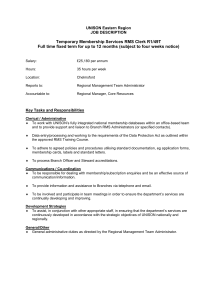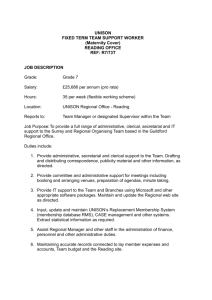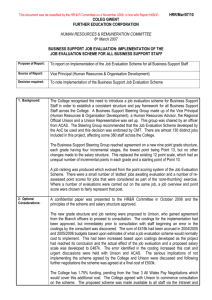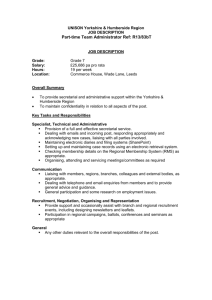performance related pay
advertisement
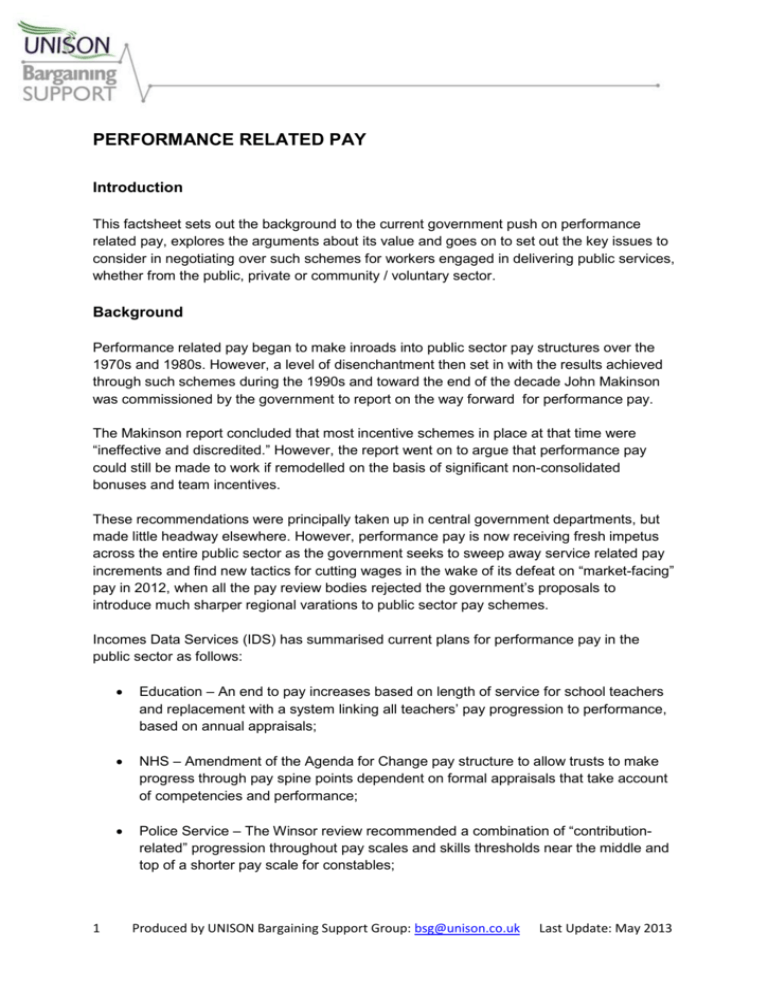
PERFORMANCE RELATED PAY Introduction This factsheet sets out the background to the current government push on performance related pay, explores the arguments about its value and goes on to set out the key issues to consider in negotiating over such schemes for workers engaged in delivering public services, whether from the public, private or community / voluntary sector. Background Performance related pay began to make inroads into public sector pay structures over the 1970s and 1980s. However, a level of disenchantment then set in with the results achieved through such schemes during the 1990s and toward the end of the decade John Makinson was commissioned by the government to report on the way forward for performance pay. The Makinson report concluded that most incentive schemes in place at that time were “ineffective and discredited.” However, the report went on to argue that performance pay could still be made to work if remodelled on the basis of significant non-consolidated bonuses and team incentives. These recommendations were principally taken up in central government departments, but made little headway elsewhere. However, performance pay is now receiving fresh impetus across the entire public sector as the government seeks to sweep away service related pay increments and find new tactics for cutting wages in the wake of its defeat on “market-facing” pay in 2012, when all the pay review bodies rejected the government’s proposals to introduce much sharper regional varations to public sector pay schemes. Incomes Data Services (IDS) has summarised current plans for performance pay in the public sector as follows: 1 Education – An end to pay increases based on length of service for school teachers and replacement with a system linking all teachers’ pay progression to performance, based on annual appraisals; NHS – Amendment of the Agenda for Change pay structure to allow trusts to make progress through pay spine points dependent on formal appraisals that take account of competencies and performance; Police Service – The Winsor review recommended a combination of “contributionrelated” progression throughout pay scales and skills thresholds near the middle and top of a shorter pay scale for constables; Produced by UNISON Bargaining Support Group: bsg@unison.co.uk Last Update: May 2013 Civil Service – The latest Treasury guidance allows for departmental pay proposals exceeding 1% if they contain plans for removing service based progression. IDS reports that only one department so far has considered buying out progression payments and the Treasury rejected the proposal on the basis that it was too expensive. Performance related pay has a longer history in the private sector and its more widespread adoption is reflected in the 2011 Workplace Employment Relations Study, which suggested that around 58% of private sector workplaces have some form of scheme, compared to 22% in the public sector. However, the study also found that, while schemes in the public sector have been on the rise over the last seven years, the private sector has seen a decline. Arguments for and against performance related pay The value of performance related pay has been the subject of much debate. The arguments most commonly used by those in favour of performance related pay are as follows: It motivates high performance in terms of both the quantity and quality of the work produced by employees; It embeds an entrepeneurial or high performance culture across an organisation; It clarifies objectives and engages employees more directly with the goals of the organisation; It can assist in addressing recruitment and retention problems, while also tempting strong candidates to apply, retaining high achievers and losing low achievers; It sends a clear message about what outcomes are valued and encourages the efficient prioritisation of tasks to achieve those outcomes; It establishes greater fairness in the treatment of staff by providing a tangible reward for those who put in greater time and effort to their work; It is an effective way of dealing with poor performance. The principal arguments against performance related pay are set out below: 2 It seeks to reduce a complex job, often involving conflicting objectives, to a few simple measures of performance; It skews effort toward those dimensions of the work that are measured, while causing neglect of many equally important areas that are more difficult to measure (the ease of measuring quantity of work in contrast to the difficulty of measuring quality is a typical example); While the idea of performance pay as a fairer system may at first seem appealing to a workforce, in its application the majority of staff are unlikely to be rated in the highest category, causing a drop off in motivation among the middle and low performers; Produced by UNISON Bargaining Support Group: bsg@unison.co.uk Last Update: May 2013 A tendency toward a narrow focus on short-term quantifiable goals can have a detrimental effect on the appraisal process, with attention diverted away from development needs and toward financial reward; Inevitable variations in the grading of staff by different managers leads to perceptions of unfairness, discriminatory practice and resentment among staff; Budgets can affect the proportion of staff an organisation permits to be graded highly, again leading to resentment and a drop-off in motivation; It has a detrimental impact on teamwork, as individuals seek to drive up their performance grading at the expense of others; It is a time consuming and costly bureaucratic burden on managers and employees; It can be a highly subjective system that is open to the prejudice and bias of local managers. Consequently, it can discriminate against individuals and groups, thereby opening up an organisation up to an increase in discrimination and equal pay claims. Context of attack on service-based increments The pros and cons of performance related pay also have to be seen in the wider context of the government’s massive budget cutting agenda and its use of “fairness” as a cover for its intentions. In trying to rally wider public support for its policies, the government often seeks to justify its current drive toward performance related pay through an appeal to “fairness” by claiming that abolition of service based pay increments would address “excessive” pay rises in the public sector and bring pay arrangements in line with the private sector. These claims frequently use false conclusions drawn from average earnings data, which are set out fully in UNISON’s Note on Average Weekly Earnings Growth Service-based increments have long been established in the public sector and elsewhere as a simple, transparent, unbureaucratic and low cost means of recognising that, as a worker gains greater experience and skill on the job, they are able to make a greater contribution to the delivery of a service and should be rewarded for that contribution. Therefore, to ensure that replacement of service-based pay with performance pay is not simply being proposed as a means of cutting costs it is crucial to assess the total funds that would be allocated under performance pay in comparison to those used to fulfil service related increments. In some areas, particularly in the community, voluntary and private sectors, there is a worrying trend for employers to go even further and seek to present performance related pay as a substitute for an annual pay rise – a position that branches should always be minded to reject. 3 Produced by UNISON Bargaining Support Group: bsg@unison.co.uk Last Update: May 2013 Evidence on impact of performance related pay As noted in the introduction to this factsheet, John Makinson was asked to review the operation of performance related pay schemes that were operating in 2000. The resulting “Incentives for Change” report noted the “stark contrast between approval of the principle and disenchantment with the practice of performance pay” before declaring that the schemes then in operation were “ineffective and discredited.” However, the report went on to assert that performance pay could still be made to work if remodelled on the basis of significant non-consolidated bonuses and team incentives. The Office of Manpower Economics, which conducts work on behalf of the various pay review bodies, commissioned a review of the evidence on performance related pay in 2007. It found that only a handful of research projects had been conducted into the impact of performance related pay (two concerning teachers, three on civil servants and three on doctors). The analysis concluded that there were insufficient robust studies to be able to say that the bulk of the evidence supported arguments in favour or against performance related pay. However, the research team still went on to claim that “financial incentives can yield productivity improvements for some public sector workers.” The same lack of evidence from rigorous studies of performance related pay was noted by Will Hutton, when publishing the Treasury-commissioned report on “Fair Pay in the Public Sector” report in 2011. However, once again he came down in favour of performance pay, though he asserted that “there is a much stronger case for linking pay to performance at the senior levels of public organisations, as opposed to the rest of the workforce,” principally because “executives have the autonomy and discretion to influence outcomes in a way that frontline staff may not.” This pattern prompted London School of Economics performance pay expert David Marsden to publish an article that aptly posed the question: “Why do We Keep Adopting Performance Related Pay Systems in the Face of Evidence That They Fail to Motivate.” Marsden went on to argue that their use is much more connected to renegotiation of performance standards among staff than anticipated improvements to motivation. However, it’s the actions of employers themselves that may represent the most telling verdict on their value. In the NHS, Agenda for Change introduced a pay structure that allowed a “gateway” near the top and bottom of pay bands, making progress through the pay structure open to assessment of performance, yet this was rarely used in practice. Equally, in local government, performance pay has long been an option for councils to pursue, yet the 2011 Local Government Workforce Survey found that 81% have chosen not to adopt performance pay for the majority of their staff. 4 Produced by UNISON Bargaining Support Group: bsg@unison.co.uk Last Update: May 2013 Negotiating a Performance Related Pay Scheme There are many different types of pay schemes that can be considered as a form of performance related pay The most common types are shown below: . Piecework - A price is paid for each unit of output (this is the oldest form of performance pay, but is mainly confined to the textile / engineering industry); Payment by results - Bonus earnings depend on measured quantities or values of output for individuals or groups, usually based on work studied time units (this system was introduced for public sector manual workers in the early 1970s); Plant or organisation wide incentives - Bonus earnings or pay levels are based on measured quantities or values for the whole establishment; Performance related pay - bonus earnings or pay progression through a pay scale are based on an assessment or appraisal of an employee’s (or team’s) performance against previously set objectives, usually as part of a performance management system; Merit pay - Bonus earnings or pay levels are usually based on a general assessment of an employee’s contributions to performance in a less structured way than is typical of the scheme above; Competence based pay - reward and training are linked to competency frameworks, based on the worker demonstrating certain skills (eg. problem solving, decision making, leadership, customer service, dealing with differing views) or achieving certain qualifications; Profit related pay - bonus or share options are based on the private company’s profit performance. If a performance related pay scheme is to be introduced, the preferable model may depend on the exact nature of the work conducted in a workplace. However, competence based pay is often seen as the option least open to the pitfalls of performance related pay outlined earlier in this factsheet. It may also be possible to advance a compromise position that allows for service-based progression through pay scales, but incorporates performance “gateways” at certain points in the scale. 5 Produced by UNISON Bargaining Support Group: bsg@unison.co.uk Last Update: May 2013 When negotiating a performance related pay scheme, it is important to consider whether the terms of the scheme address the points below. Equality considerations are a major theme throughout these points as equality provides union negotiators with one of the main means of influencing performance related pay proposals and avoiding the worst excesses. 6 Scheme Design - Trade union involvement in design of the scheme from the start, allowing for negotiability over the type of scheme adopted, performance objectives and funds allocated to the scheme. In particular, design should check that performance criteria and objectives are not discriminatory eg are they equally achieveable in jobs typically carried out by women and men, is there any any indirect discrimination in the criteria selected (such as attendance records) and are part-time staff disadvantaged in comparison to full-timers? Piloting - The scheme should be piloted to ensure that it achieves its objectives and does not operate unfairly; Equality Impact Assessment – An equality impact assessment would be the most effective way for an organisation to fulfil its obligations under the Equality Act to assess the impact of introducing such policies as performance related pay on promoting equality. The Equality and Human Rights Commission has produced a valuable checklist that evaluates all aspects of scheme design / staff outcomes and is available here ; Transparency - The scheme should allow clarity to every individual over the structure of their appraisal process, how their rating has been arrived at and how that rating has been converted into a financial reward; Adequate appraisal – Sufficient time should be available to managers to carry out any appraisals, as the workload implications can be considerable, especially for a complex scheme. Performance pay should not be allowed to skew appraisals away from a comprehensive appraisal system that encourages personal development. In addition, it is generally preferable for performance payments to be related to objective criteria, with limited scope for managerial discretion. Where discretion remains, clear guidelines should be established on the exercise of that discretion; Training – The scheme should specify training requirements for managers, covering awareness and avoidance of bias, in order to allow for the effective and fair operation of the scheme. For example, managers should be made aware of the risks of undervaluing the contribution of part-time staff. Without good training and corporate guidance, managers’ prejudice can influence performance related pay scores without them necessarily even being aware that they are being discriminatory; Record keeping – Systematic records need to be kept of payments made along with the reasoning behind the decisions in a consistent, up-to-date format; Produced by UNISON Bargaining Support Group: bsg@unison.co.uk Last Update: May 2013 7 Monitoring - While not revealing individual results to all staff, the scheme should be sufficiently transparent at a collective level to allow for consistency checking across departments and identification of any equality issues in results across all groups defined as showing protected characteristics under the Equality Act (see equallity factsheet for full list). Agreement should be established for a full review of the scheme on at least an annual basis and, if results reveal any significant differences for protected groups, these should be investigated further; Fairness – All aspects of the scheme should be assessed to ensure fairness in its operation. In competence based pay schemes for example, all staff should have equal access to training. In the case of private and community/voluntary organisations, the use and scale of performance related pay can vary from contract to contract, prompting the need to consider negotiating a central fund for allocating to performance pay schemes equally; Appeals – The appeals process for anyone to challenge their rating under the scheme should be clearly defined and display clear independence from the management that may have delivered the original biased results. Produced by UNISON Bargaining Support Group: bsg@unison.co.uk Last Update: May 2013


